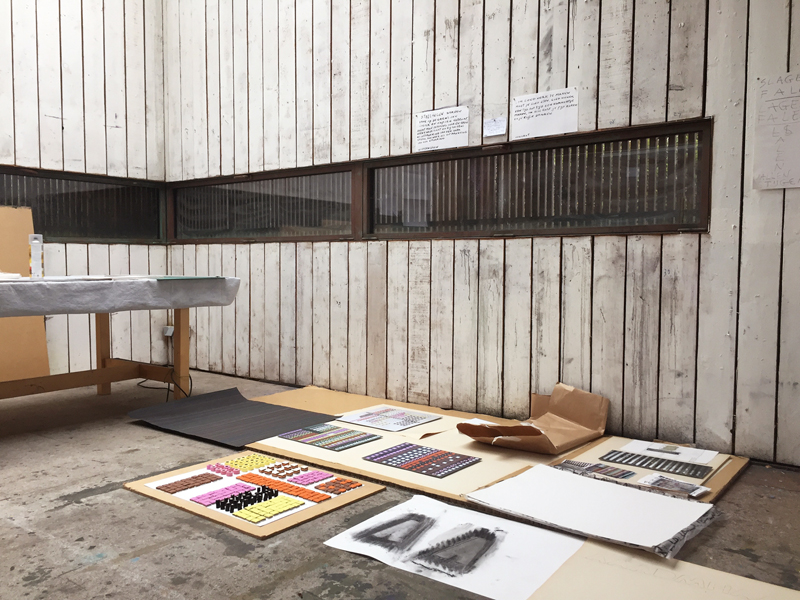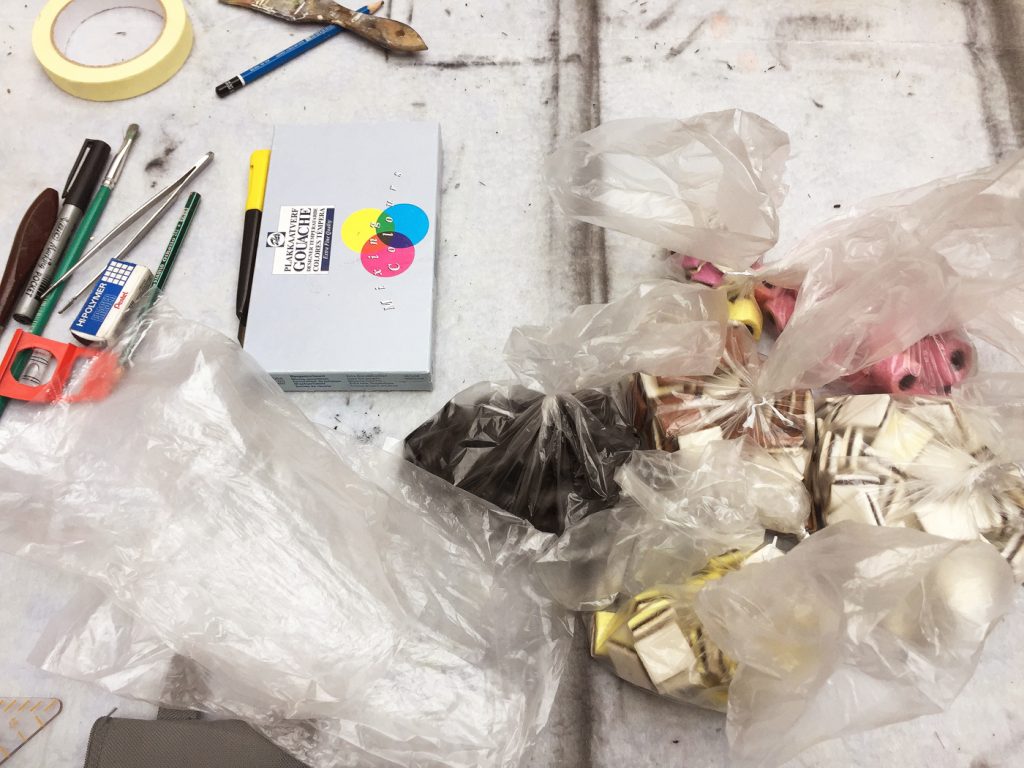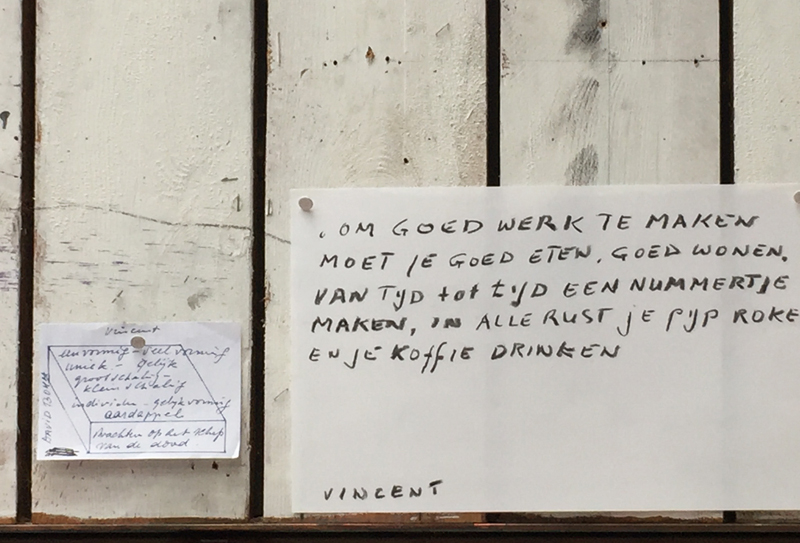
Though there is a great deal in the studio upon our arrival, Sef Peeters is not accustomed to any of it. All of that can be found in his own studio. The studio here in Zundert is empty, save the memory of the previous users, which Sef has removed as much as possible via a thorough cleaning.

With nothing in your hands
A working period entails setting up residence elsewhere, and then seeing what happens. What is the significance of such a place? How do you work in a strange studio — sans real walls, that resembles a prison and part of a shop-window? “I have no craft, no profession, because I’m a conceptual artist. I could not envision beforehand what to bring to be able to work. Nor do I have any particular interest in Vincent, apart — a quote not easily found in the classical literature on Vincent van Gogh because it contradicts the myth of the tormented artist.”

To make good work, you have to eat well, live well, compose a tune from time to time, smoke your pipe and drink your coffee in peace.
Today’s world differs from Vincent’s time. Zundert has also changed. The houses have changed, the streets, the people … even the ideas about creating art. “I saw the dahlia fields and the tightly planted rows in the nurseries around Zundert, all neat and efficient. I’m a gardener’s son and immediately recognised the world of my childhood. I stepped inside the Dirk van de Broek here, where English liquorice was on sale. Tasty I thought to myself, buying the liquorice. But then the penny dropped in the studio. The liquorice became the material I used to depict the world in which I had landed, and something like this only possible when you have nothing.”

Keep breathing
Though Sef wanted to focus all of his attention on the residency in Zundert, he had also been invited to exhibit at the Cokkie Snoei gallery in Rotterdam, which fell just within the same period. He thought he would need a few days for the gallery, but that turned into a whole week and then into a break in the working period. It insinuated itself into the working process and, after the opening, he came down with a very bad cold.
“Sjarel Ex opened the exhibit with a wonderful speech about my work, referring to me as a master of failure. So, that also played a role during the second half of my work period: the failure. And that’s no longer something that I can do without worrying. Failure now also creates expectations. I view it as a kind of wheel of fortune, a sort of cycle. It goes up then comes down once more. In these drawings, the words success and failure, moving clockwise, played a role. Another idea that’s been with me for years, but that I could only implement here, is breathing. This had been churning around for so long, it simply had to happen. Ultimately, this became the main theme. The notion comes from my own history: just keep going, keep breathing. I found the necessary concentration here, so I could make it here.”

With the wrong things
When asked, Sef indicates that, for him, the most important discovery may be that things continue like normal. They may fail, but being unsuccessful is not the same thing as failure. “Vincent’s quote can also signify the very opposite of resting and reflecting at your own pace as an artist to create great work. Namely, that you may not have to make art at all. But I do think he was always an artist, at any rate, more than he was a pastor. He was a landscape painter in how he looked at things, although the landscape was probably far messier in his time.
I can be rather serious. I try to get to know myself and to share myself through my work. But, there’s always some doubt about what’s in it for others. Being light and thinking light is fun, but where’s the message to the people? I may be a bit of a “pastor” myself. But I feel lightness again; I can play once more. For me, making work is a way to find a language that’s also meaningful to others. That can give you a good feeling, that something is meaningful. The work ‘slagen en falen met een kleine g’ is my favourite. I had no G between the letters I used, which made it virtually impossible to succeed. The drawing — the work — was heavy, it centred on a heavy topic, but it still had humour.”

Like an exhibit
The problem with working periods is having to show work at the end, because sometimes it is not yet clear how to judge the output. The works often comprise discoveries that are only in the early stages. Do they represent a side jaunt or the start of something new? And how or when do you know? Despite this, you go ahead and show it, or maybe even because of it? Is the sum of all the impressions an exhibit or a report?
“An exhibit is quite absolute. And the pressure to perform can be less than pleasant. Though it’s the logical conclusion of a residency, it’s also stressful. Things have to be made, completed, because there are volunteers who keep the gallery open. I also have to deliver two small works. This creates obligations, even more than I had wanted. Quite a while back, I had promised to give a workshop, the New Vincent, to young people at the end of a working period. I thought that it would coincide with the exhibit here; as it turned out, it did not. I then had to think up something, spending time on that rather than on my own work. I wanted to give the young people a small taste of my own residency. So, I gave them an assignment, after which they were allowed to paint. The catch was that I had hidden the brushes, so they had to figure out their own working method. Whether they now have more knowledge about making art or even about Vincent, I don’t know. I’ve started to think differently about Vincent myself, or more accurately, I’ve started to think about him more; I’ve never thought about it that way.”

Sef Peeters worked as an artist-in-residence in the guest studio of Vincent van Gogh House in October 2018. The results of this working period were exhibited from 2 to 30 November 2018 in the Van GoghGalerie.
Author: Esther van Rosmalen
This article has also been published on Witte Rook (in Dutch) on 28 November 2018

